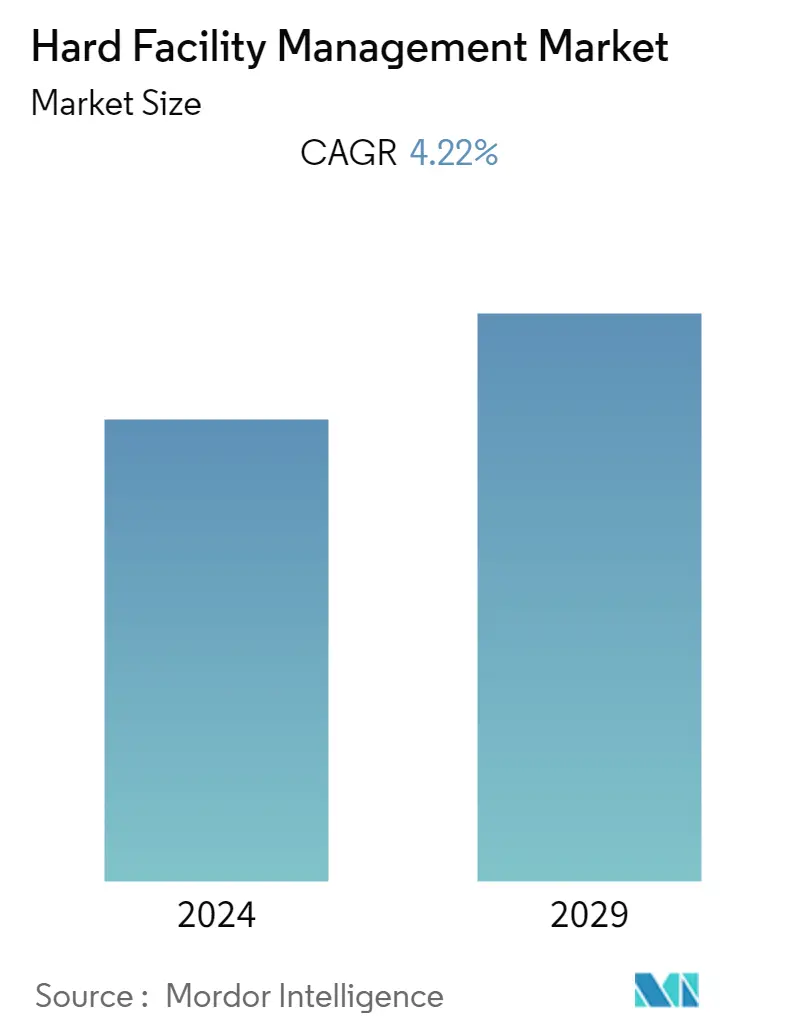Market Size of Hard Facility Management Industry

| Study Period | 2019 - 2029 |
| Base Year For Estimation | 2023 |
| Forecast Data Period | 2024 - 2029 |
| CAGR | 4.22 % |
| Largest Market | Asia-Pacific |
| Market Concentration | Low |
Major Players
*Disclaimer: Major Players sorted in no particular order |
Need a report that reflects how COVID-19 has impacted this market and its growth?
Hard Facility Management Market Analysis
The HFM Market is expected to record a CAGR of 4.22% over the next five years. The need for HFM services is rising as industrialization and development are occurring around the globe. Additionally, there is a greater need for these services due to the expansion of corporate offices, shopping centers, and retail establishments.
- Due to the increase in infrastructure-related activities, particularly in developing nations like China and India, the hard services category is expected to grow during the forecast period. The demand for hard services like heating, ventilation, and air conditioning (HVAC) and mechanical and electrical maintenance has increased due to the increase in infrastructure-related activities. The real estate sector is expected to witness strong growth on the back of increased commercial and infrastructural development and remodeling efforts across the globe.
- Enterprise asset management (EAM), refers to the administration of an organization's physical assets throughout each asset's life cycle. EAM solutions offer asset health information and day-to-day administration, which is crucial for businesses that depend on vital infrastructure assets to sustain their customers and satisfy business and regulatory objectives. Enterprises across the words are investing huge sums of money in EAM.
- Both before and after the pandemic, HFM services have experienced faster growth than entire economies, despite significant entry barriers. This demonstrates the vitality of these professions and the ease with which employers can fill job positions in them (as opposed to soft services), thanks to both higher pay rates and the higher switching costs entailed by these highly specialized skill sets.
- The current state of the labor market is one of the main problems for the sector. The HFM sector needs qualified, partially qualified, and unskilled workers. More professionals still need to manage large-scale infrastructure projects, particularly in the technical services sector. As a result, keeping up with the industry's rapid growth is difficult because most professionals still need extensive training and time to understand their roles thoroughly. Retaining labor is also an issue because unskilled laborers are prone to changing employment.
- After the restrictions related to the pandemic ended, returning to the workplace was made possible. Due to more rigorous hygiene standards in the workplace, there has been an increased need for facility management services in recent years. Owing to the application of social distancing guidelines, many HFMs had to redesign office layouts compulsorily, spacing desks apart and installing screen barriers to prevent too close contact. For the upcoming several months, all sectors of complex facility management are expected to witness a considerable demand surge.
